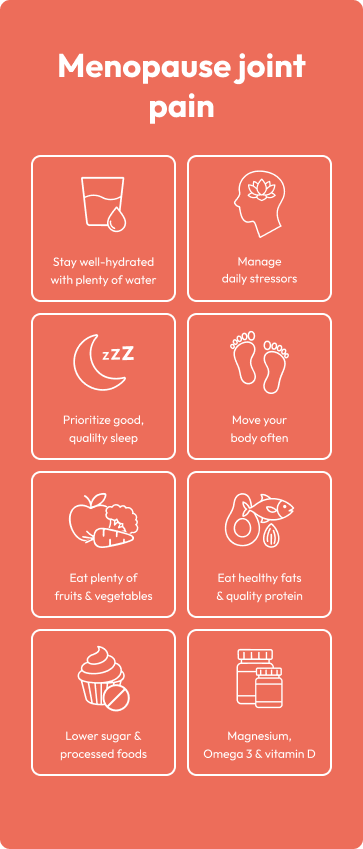Joint pain: Causes, symptoms, & treatments
If you’ve started to notice new aches in your knees when you bend down, stiffness in your hips when you get out of bed, or a lingering soreness in your shoulders after carrying groceries, you might wonder what’s changed. You’re doing the same things you always have, but your body seems to react differently.
You’re not alone. What you might not realize is that these changes can be connected to perimenopause or menopause, a phase of life when estrogen levels begin to fluctuate and then gradually decline. Joint pain is a very common symptom during perimenopause and menopause, yet it’s rarely talked about openly, and it’s completely normal, but that doesn’t make it any less frustrating or disruptive.
We’ll walk through why it happens, what it tends to feel like, and what you can do to help your joints feel more comfortable again.
What causes joint pain in menopause and perimenopause?
Your hormones do much more than regulate your period. Estrogen, in particular, has a protective effect on your joints. It helps keep inflammation under control, supports collagen (the protein that cushions your joints), and maintains healthy lubrication so your joints move smoothly.
As estrogen levels fluctuate and eventually decline, that support system becomes less stable. Several things start happening at once.
1. Increased inflammation
Estrogen naturally helps regulate inflammation as it has anti-inflammatory properties. When levels drop, inflammatory chemicals in the body can rise, making your joints more sensitive, more reactive, and slower to recover from everyday activities, even simple activities like picking up your groceries. Movements that used to feel easy may now leave you feeling sore or stiff.
2. Loss of joint lubrication
Joints rely on synovial fluid, a slippery liquid that helps bones glide past each other. With less estrogen, this fluid can become thicker, and your body may start to produce less of it. As a result, joints may feel dry, tight, or “creaky,” especially first thing in the morning or after sitting still for a while. That’s why sitting on the floor and getting back up can be a bit painful and difficult to do without hearing cracking noises.
3. Reduced collagen and muscle tone
Estrogen supports collagen production, which keeps cartilage and connective tissues strong and flexible. When estrogen declines, collagen breaks down more quickly and is rebuilt more slowly. At the same time, natural age-related muscle loss means there is less muscle protecting and stabilizing your joints. Together, that can lead to more strain and discomfort.
4. Sleep, stress, and weight changes
Night sweats, anxiety, insomnia, or sleep apnea can all disrupt sleep, and poor sleep increases both inflammation and pain sensitivity. Many women also notice weight shifting toward the midsection during midlife. Even a small amount of additional weight can add extra pressure to weight-bearing joints such as the hips, knees, and lower back, making discomfort more noticeable.
Dr. Sheryl Ross (Dr. Sherry), Chief Medical Officer of Women’s Health at QuickMD, explains it this way:
“As estrogen levels drop, inflammation can increase, and the tissues that protect your joints lose some of their flexibility. That’s why many women start feeling soreness or stiffness, even without injury or major lifestyle changes.”
As we get older, our muscle mass naturally declines, which means our joints have to work a little harder to do the same motions we’ve always done. Add in disrupted sleep, stress, and maybe a few extra pounds, and those aches can start to feel like a frustrating new baseline.
But it doesn’t have to stay that way.


What joint pain during menopause feels like
No two women experience menopause or perimenopause the same way, and joint pain is no exception. For some, it’s a dull stiffness. For others, it feels like sharper twinges or a deep ache that seems to move from one joint to another.
Common experiences include:
- Morning stiffness that eases once you move around
- Aches or soreness in the knees, hips, shoulders, hands, or lower back
- Tightness or swelling after periods of sitting or resting
- A heavy, tired feeling in the joints, almost like you’re muscles are weighed down
- Clicking or grinding sensations when bending, reaching, or climbing stairs
- Pain that flares or feels worse after a poor night’s sleep or during stressful occurrences
Some days, your joints may barely bother you. Other days, you might wake up and feel like your body aged overnight. These ups and downs are very typical as hormone levels rise and fall.
How to relieve joint pain during menopause
Joint pain related to menopause is common, but it is not something you have to simply accept. There are several approaches that can help you move more comfortably.
Menopause hormone therapy (MHT)
Because estrogen impacts joint comfort and inflammation, menopause hormone therapy (MHT) can make a real difference for many women. By restoring estrogen levels, MHT can:
- Reduce the underlying inflammation that drives stiffness and soreness in your joints
- Support collagen and joint tissues, helping them stay more cushioned and flexible
- Improve joint lubrication, so movement feels smoother and less clicky or creaky
Many women notice that mornings feel easier, recovery after activity improves, and their overall comfort increases once their hormones are better balanced. MHT is not right for everyone, but for women who can take MHT, it can be a life-changing treatment. Your QuickMD doctor can help you understand whether it fits you and your health history.
Heat and cold therapy
Heat and cold are simple, at-home tools that can provide quick relief when your joints are acting up.
Heat therapy
Warmth helps relax tight muscles, loosen stiff joints, and increase blood flow. A warm bath, heating pad, or warm compress can be especially helpful first thing in the morning or after long periods of sitting. If you’ve ever gone to a chiropractor, you’ll know that they typically start with heat therapy to relax the muscles before doing any adjustments. It’s an effective method.
Cold therapy
Cold is useful when joints feel swollen, warm, or irritated. An ice pack or cool compress can help calm inflammation and soothe more acute discomfort. And, as a bonus, if you experience hot flashes, having a nice cold ice pack can be relieving in more ways than one.
You can use heat for about 10 to 15 minutes before getting up or after sitting, and cold for about 10 to 15 minutes after activity if a joint feels irritated. If your discomfort varies, alternating heat and cold can help. These therapies don’t correct hormonal changes, but they do give your joints much-needed relief while you explore longer-term treatment options with your doctor.
Exercise
When your joints hurt, moving more can feel counterintuitive. But gentle, consistent movement is one of the best ways to reduce joint pain in menopause.
Strength training helps rebuild and maintain the muscle that surrounds and supports your joints. With stronger muscles, your joints don’t have to absorb as much impact. Simple options like bodyweight squats, resistance-band exercises, or light dumbbells can be enough to make a meaningful difference over time.
Dr. Sherry shares, “Exercising as little as 30 minutes, 3 days a week can show immediate health benefits. Aerobic exercises such as brisk walking, jogging, bicycling, and swimming are especially helpful for menopausal women. These types of activities help with weight loss or allow women to maintain a healthy weight.”
Low-impact activities increase blood flow to your joints and help you stay mobile without adding extra stress. Many women also find stretching, yoga, and Pilates helpful for keeping their hips, back, and shoulders more flexible.
Lifestyle changes
Relieving joint pain often comes down to small, everyday choices that support your body over time.
A healthy weight can lessen the pressure placed on your joints, especially your hips, knees, and ankles. Eating a diet rich in vegetables, fruits, whole grains, and healthy fats like nuts, seeds, and fish can help lower inflammation and support tissue repair. Staying hydrated also helps keep cartilage and connective tissue cushioned and resilient.
Your day-to-day habits also matter. Taking short stretch breaks during long periods of sitting, changing positions more often, not leaning on one leg more than the other, and being mindful of your posture all help your joints feel better. Avoiding smoking and keeping alcohol in moderation can also support both joint health and your overall well-being.
Sleep is part of this picture too. When sleep is disrupted by night sweats or other disruptive symptoms, your body becomes more sensitive to pain. Creating a calming wind-down routine, keeping your bedroom cool, and talking with a doctor about any sleep issues can make a noticeable difference in how your joints feel the next day.
Experiencing joint pain during menopause? See how hormone therapy can help joint health and inflammation.
Hormonal shifts during menopause can lead to stiffness, soreness, or aching joints, even if you’ve stayed active and healthy, but you don’t have to just push through it. QuickMD doctors can help restore hormonal balance to support flexibility, reduce inflammation, and improve your day-to-day comfort.
We just launched our Menopause Hormone Therapy Membership in select states, and your first month’s on us. You’ll get to meet with a doctor, ask all your questions, and see if treatment might help.
If you love it and want to keep going, it’s $ 79/month after that, with special member pricing on medication and regular access to your doctor. And if you decide it’s not for you – that’s totally fine too. Get started by booking your free visit now.

